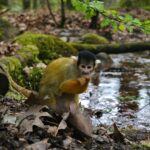Picture this: the vibrant heart of our planet – the tropical rainforest, teeming with life. But hidden amidst this beauty lurks a silent threat, slowly choking the life out of this vital ecosystem. These invaders, brought in by human actions, are pushing out native species, disrupting the natural order, and changing the very heart of the rainforest. From towering trees to the smallest insects, it’s a race against time to stop these invaders and protect these irreplaceable treasures. Let’s journey into the world of invasive species and explore how we can fight back to save our rainforests.
Unwelcome Guests: How Invasive Species Disrupt the Rainforest Balance
Imagine a species arriving in a new environment, not to coexist, but to conquer. These invasive species often possess traits – rapid growth, aggressive reproduction, or a lack of natural predators – that give them an advantage over native species. This creates an uneven playing field where the delicate balance of the rainforest is thrown into disarray.
These invaders are like unwelcome houseguests who overstay their welcome and consume all the resources, leaving little for the rainforest’s rightful inhabitants. They gobble up nutrients and water, starving native plants and weakening the entire forest.
The problems escalate when invasive predators enter the scene. They decimate native populations unaccustomed to their hunting tactics, leaving gaps in the food web and potentially pushing some species towards extinction.
But the destruction doesn’t stop there. Invasive plants can physically alter the rainforest. Some species grow in dense mats, blocking sunlight from reaching the forest floor, hindering the growth of native seedlings and disrupting the cycles of decomposition and nutrient recycling.
Invasive species can even increase the rainforest’s vulnerability to wildfires. Fast-growing grasses dry out the forest floor, acting like kindling and fueling the spread of fires. These invaders often outcompete native vegetation, returning stronger after a fire and creating a cycle of destruction.
The question then arises: how did these troublemakers infiltrate these pristine ecosystems? Sadly, humans often play a role. Deforestation for timber, agriculture, and development creates openings for invasive species to exploit. Global trade, though essential, can unintentionally transport invasive species in cargo ships or even on the soles of our shoes.
The Three Biggest Threats to Rainforests: A Complex Web of Destruction
The world’s tropical rainforests, often called the “lungs of our planet,” face a trio of interconnected threats: deforestation, climate change, and invasive species.
1. Deforestation: A Cut Above the Rest
As the global population grows, so does the demand for land. In tropical regions, this often translates to clearing rainforests for agriculture, timber extraction, and infrastructure development. However, deforestation not only removes trees but also displaces countless plant and animal species that depend on these forests for survival. Moreover, it disrupts the Earth’s climate regulation system, as trees play a crucial role in absorbing carbon dioxide.
2. Climate Change: Turning Up the Heat
Climate change is like a fever dream for rainforests – unpredictable and dangerous. Rising temperatures and shifting rainfall patterns lead to more frequent and severe droughts, floods, and wildfires. These extreme events push the adaptability of rainforest species to their limits, potentially leading to irreversible damage and biodiversity loss.
3. Invasive Species: Unwanted Guests
Much like unwelcome party crashers, invasive species disrupt the delicate balance of rainforest ecosystems. These non-native plants and animals compete with native species for resources, often outcompeting them due to their aggressive growth and reproductive strategies. They can also introduce diseases, further threatening the survival of native species and disrupting the intricate web of life in the rainforest.
The Human Footprint: Our Actions Have Consequences
The introduction of invasive species to rainforests is often a byproduct of human activities. We transport goods, plants, and animals across the globe, inadvertently providing pathways for invasive species to hitch a ride.
Sometimes, introductions are intentional. People might bring in exotic plants for their gardens or animals as pets without realizing the potential consequences for the delicate rainforest ecosystem. Once established, these species can spread rapidly, outcompeting native species and disrupting crucial ecological processes.
Climate Change: Rainforests Under Fire
Climate change is not just a distant threat; it’s actively reshaping the rainforest as we know it. Imagine a delicate balancing act thrown into chaos. That’s what rising temperatures and erratic rainfall patterns are doing to these precious ecosystems.
Extreme heat intensifies droughts, turning lush rainforests into tinderboxes. When rain does arrive, it often comes in the form of torrential downpours, causing landslides and washing away the nutrient-rich soil that sustains life.
But the impact goes beyond immediate damage. Entire species, some found nowhere else on Earth, are being pushed towards extinction as their habitats transform. The intricate web of life is unraveling.
Rainforests are crucial carbon sinks, absorbing vast amounts of carbon dioxide from the atmosphere. However, deforestation and degradation release this stored carbon back into the atmosphere, exacerbating climate change. It’s a dangerous feedback loop that needs to be broken.
Protecting Paradise: Our Shared Responsibility
The challenges facing tropical rainforests are complex and interconnected, but understanding these threats is the first step towards effective conservation.
Here are some ways we can make a difference:
- Support Sustainable Practices: Encourage and support sustainable agriculture, forestry, and development practices that minimize deforestation and habitat fragmentation.
- Combat Climate Change: Advocate for policies that reduce greenhouse gas emissions and promote renewable energy sources.
- Prevent the Spread of Invasive Species: Support stricter biosecurity measures, border inspections, and public awareness campaigns to prevent the introduction and spread of invasive species.
- Promote Responsible Tourism: Choose eco-friendly tourism operators that minimize their impact on rainforests and support local communities.
- Support Conservation Organizations: Donate to or volunteer with organizations working to protect rainforests and the species that depend on them.
The fate of tropical rainforests lies in our hands. By understanding the threats they face and taking action, we can ensure that these vital ecosystems continue to thrive for generations to come.
Discover whether trains play a crucial role in the efficient transportation of goods to the Appalachian Plateau by exploring this informative article: do trains transport goods to the appalachian plateau.
- Unlocking 2-Letter Words with U: The Definitive Guide - April 4, 2025
- Unlock Words with the Letters THREE: Top Unscramble Tools 2025 - April 4, 2025
- Master Scrabble: X & Z Words for High Scores - April 4, 2025
















